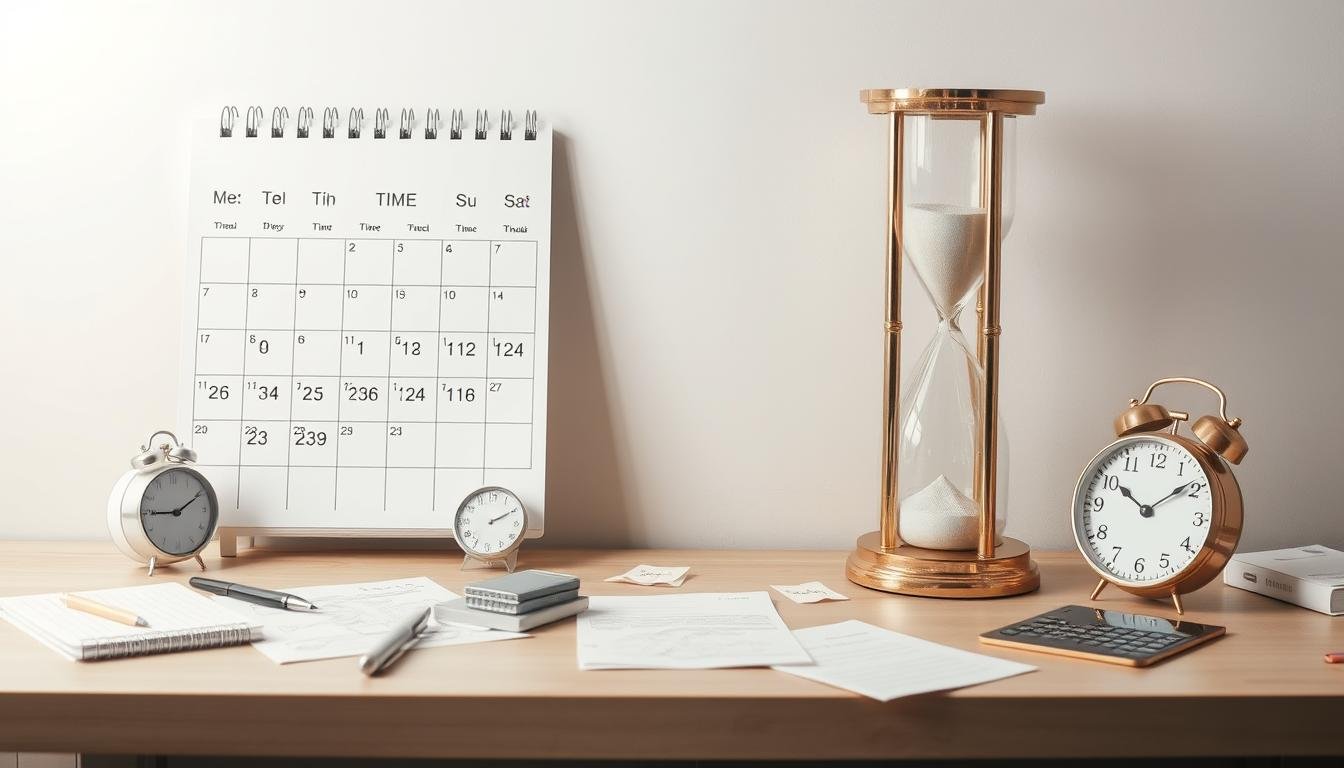A visually appealing infographic-style illustration depicting the conversion of days to years. Include a circular calendar with days marked, transitioning smoothly into a year representation featuring four seasons. Use vibrant colors to differentiate between the days and years, and incorporate symbols like clocks and hourglasses to emphasize the concept of time. The background should be soft and abstract to highlight the conversion theme without any text or characters.
Time conversion is vital in many life areas. Day-to-year calculations help track projects and milestones effectively.
Time measurement transforms complex data into meaningful insights. It’s more than just simple math.
Mastering time conversion skills can give you significant advantages. Many fields rely on accurate time measurement techniques.
This guide shows how to convert days to years. We’ll explore methods and share real-world examples.
You’ll learn all about day-to-year calculation. Our toolkit will help you make precise time conversions.
Time conversion isn’t just about numbers. It’s about understanding how we track time in different situations.
Our approach makes the process easy for everyone. You’ll gain a deeper grasp of time perception.
Understanding the Basics of Time Conversion
Time units are how we measure moments, days, and years. Different calendars track time uniquely, making conversion crucial for accurate calculations.
An astronomical year is Earth’s complete orbit around the sun. This measurement helps scientists standardize time calculations across various contexts.
Time measurement is complex. Calendar systems differ across cultures, using solar, lunar, or lunisolar approaches.
Experts often convert between time units. Translating days to years provides insights into data, timelines, and records.
Effective conversion requires understanding measurement principles. Precise time unit conversions are vital for accurate analysis.
The Day-to-Year Conversion Formula
Converting days to years needs careful math. The basic formula divides the total days by 365.
Leap years add an extra day every four years. This changes the calculation a bit.
The standard formula is: Total Years = Number of Days ÷ 365.25. This accounts for leap years in the average yearly calculation.
For precise conversions, follow these steps: – Count the total number of days – Divide by 365.25 to account for leap years – Round to the nearest decimal place for accuracy – Verify the calculation using multiple methods.
Exact calculations are vital for time tracking and research. Understanding leap years helps get accurate results when converting days to years.
Real-Life Examples of Day-to-Year Conversion
Day-to-year conversion is vital in many real-life situations. It’s helpful in calculating exact ages and tracking personal growth.
Project managers use this method for long-term planning. It helps them schedule tasks and allocate resources more effectively.
Athletes use day counts to measure their training progress. This approach shows their dedication and improvement over time.
Scientists rely on precise time tracking for their research. They convert observation periods to study gradual changes or experiment results.
Investors use day-to-year conversion for financial planning. It helps them make smart choices about their money and future.
These examples show how practical this conversion is. It applies to personal growth, work, and money matters.
Tools for Converting Days to Years
Digital calculators have changed how we convert time. Modern tools make changing days to years easy and fast.
Online platforms now do complex time math instantly. No manual work is needed.
Time apps offer precise day-to-year conversion features. They have user-friendly designs for easy use.
Both pros and students use these tools. They help with time-tracking and planning.
Some great online tools stand out. TimeAndDate.com and Calculator.net offer free, easy-to-use converters.
Mobile apps like Unit Converter and Time Calc work on phones. They let you do quick math anywhere.
Good digital calculators are accurate and straightforward to use. They also work on different devices.
Some apps can convert more than just days and years. These are great for complex planning needs.
Choose a tool that fits your needs. The correct calculator can boost your productivity.
Benefits of Knowing Days to Years Conversion
A serene workspace featuring a large calendar with days marked and an elegant hourglass symbolizing the passage of time, surrounded by scattered notes and clocks displaying different time zones, all set against a soft gradient background that evokes a sense of organization and clarity.
Converting days to years helps with personal and job growth. It makes goal setting more exact and helps manage big projects.
This skill aids in detailed historical studies. Scholars can make better timelines with it.
It improves time management, too. People can see long-term goals in smaller chunks.
Students and workers in many fields gain from this skill. It helps in planning research and tracking career progress.
Quick day-to-year conversion allows for better project planning. It also helps track long-term goals.
This skill boosts research and analysis abilities. It enhances overall time management, too.
Mastering time conversion is a key tool. It helps in planning and understanding time across various settings.
Common Mistakes in Conversion
Converting days to years can be tricky. Errors often come from missing key details that affect math precision.
A common mistake is mishandling leap years. This can throw off calculation results by a lot.
Day-to-year conversions need careful attention to detail. People often use simple formulas without thinking about complex calendar changes.
Standard 365-day math might miss leap years. This can cause problems in long-term time measurements.
Precision is key in time conversions. Experts suggest checking calculations using different methods.
Spreadsheets and online tools can help reduce human error. They ensure accuracy in time calculations.
To avoid errors, understand leap year rules. Use consistent methods and check results from multiple sources.
Account for partial-year calculations. Be aware of potential rounding issues.
Pay close attention to details for better day-to-year conversions. Small mistakes can lead to big problems in time-related data.

Converting Days to Years for Different Purposes
Day-to-year conversion is vital in many areas of life. It helps determine age and track progress in various fields.
Project managers use this skill to plan effectively. They can estimate completion dates and allocate resources better.
Travelers use day-to-year conversion to understand trip durations. It provides insights into their personal and professional experiences.
Healthcare pros need exact age calculations for their work. They study life expectancy and developmental milestones using this method.
This skill helps people make wise choices. It’s useful for personal goals, project management, and data analysis.
FAQs About Days to Years Conversion
Time conversion can be tricky. Let’s explore common questions about changing days to years.
A standard year has 365 days. Leap years have 366 days, affecting precise calculations.
Simple math doesn’t always work for conversions. Different situations need different methods.
Online tools help with accurate conversions. They prevent errors in manual calculations.
Precise day-to-year changes matter in many jobs. This helps with time-based estimates and calculations.
Context is key when converting time. Check if you’re using standard years or remarkable frameworks.
Always verify your source and method. Minor differences can significantly affect long-term calculations.
Additional Resources for Time Conversion
Time conversion resources can boost your math skills. Many materials are available to help you learn about time measurement.
Online platforms offer great ways to master time-related math skills. Coursera and edX have complete courses on math conversions.
These resources include video lessons and fun exercises. They break down hard math into manageable steps.
Khan Academy and Math is Fun offers free lessons on time conversions. They make challenging ideas easy to understand.
You can find guides, practice problems, and tools that make learning fun. Bookstores have unique books about math conversions.
McGraw-Hill and Pearson publish books with clear examples. These books help you learn time math in depth.
Workshops and webinars teach time conversion skills, too. Math groups often host online and in-person classes.
These classes give helpful tips for school and work. You can learn skills that help in many areas.
Conclusion: Mastering Time Conversion
Time conversion is more than just math. It helps you manage time better at work and in life.
Converting days to years is a valuable skill. It helps track progress and plan projects.
Anyone can learn time conversion with practice. It’s not hard, just needs some effort.
This skill helps in many areas. Use it for personal goals, work projects, or studying history.
Keep learning and trying new methods. Each way of converting time teaches something new.
Practice often to get better. Soon, you’ll do time calculations easily.
Time conversion skills grow with use. Keep using them to improve your skills.
FAQ
How many days are in a standard year?
A standard year has 365 days. To convert days to years, divide the total days by 365.
Do leap years affect day-to-year conversions?
Yes, leap years impact conversions. They have 366 days instead of 365.
For precise calculations over long periods, account for leap years.
What’s the simplest way to convert days to years?
Divide the total days by 365. For example, 730 days equals 2 years (730 ÷ 365 = 2).
Are there online tools for converting days to years?
Yes! Many free online calculators can quickly change days into years.
Websites like Calculator.net and ConvertUnits.com offer easy-to-use conversion tools.
How do I calculate partial years?
Divide the total days by 365 and keep the decimal point.
For example, 400 days is about 1.10 years (400 ÷ 365 = 1.10).
Why is understanding day-to-year conversion necessary?
It’s vital in project management, age calculation, and scientific research.
Day-to-year conversion helps provide a clear view of more extended periods.
How do different calendar systems impact day-to-year conversions?
Various calendars can slightly affect conversions. The Gregorian calendar has 365 days.
It includes leap years every four years. Other calendars might have different calculations.
Can I convert years back to days?
Yes, multiply the number of years by 365. For leap years, add an extra day.
You may also read:Unlocking the Secrets of 40: Understanding Its Factors
